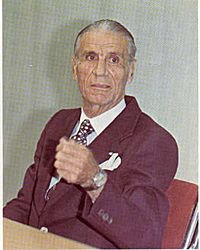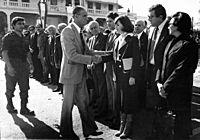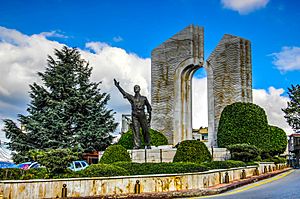Pierre Gemayel facts for kids
Quick facts for kids
Pierre Gemayel
|
|
|---|---|
|
بيار الجميّل
|
|
 |
|
| 2nd President of the Lebanese Football Association | |
| In office 1935–1939 |
|
| Preceded by | Hussein Sejaan |
| Succeeded by | Farid Ammoun |
| Member of Parliament for Beirut | |
| In office 1960–1984 |
|
| Personal details | |
| Born | 6 November 1905 Bikfaya, Beirut Vilayet, Ottoman Empire |
| Died | 29 August 1984 (aged 78) Bikfaya, Lebanon |
| Resting place | Bikfaya |
| Nationality | Lebanese |
| Political party | Kataeb Party |
| Spouse | Genevieve Gemayel |
| Relations | Grandsons: Pierre Amine Gemayel Samy Gemayel Nadim Gemayel |
| Children | 6 children, including: Bachir Gemayel Amine Gemayel |
| Alma mater | Saint Joseph University |
| Occupation | Pharmacist |
Pierre Gemayel (born 6 November 1905 – died 29 August 1984) was an important political leader from Lebanon. He was a Maronite Catholic, which is a Christian group in Lebanon. People remember him for starting the Kataeb Party, also known as the Phalangist Party. He was also a powerful figure in the Lebanese parliament.
Pierre Gemayel was the father of Bachir Gemayel and Amine Gemayel. Both of his sons became presidents of Lebanon during his lifetime. He did not like the idea of French control over Lebanon in the 1930s and 1940s. He wanted Lebanon to be a truly independent country, free from outside influence.
He was known for being very skilled in politics. Sometimes, his decisions seemed to change, which his supporters saw as practical. However, his opponents thought these changes were confusing. Even though he first supported the Palestinian cause, he later changed his mind. This happened because some Palestinian groups supported a movement that wanted to change Lebanon's political system.
Besides politics, Pierre Gemayel also had a career in football in the 1930s. He was the captain of the Lebanon national team. He also became the first Lebanese football referee to work in international matches. From 1935 to 1939, he was the second president of the Lebanese Football Association.
Contents
Who Was Pierre Gemayel?
Pierre Gemayel was born on 6 November 1905 in Bikfaya, Lebanon. His family was Maronite Christian. His father, Amine Bachir Gemayel, and his uncle had to leave Lebanon in 1914. They were sentenced to death for opposing the rule of the Ottoman Empire. They only came back to Lebanon after World War I ended.
Pierre Gemayel went to a Jesuit school. Later, he studied pharmacy at a French medical school in Beirut. After finishing his studies, he opened his own pharmacy there. He also owned a pharmacy in Haifa, which was in Palestine at the time.
Early Life and Learning
Pierre Gemayel was born into a family that cared deeply about Lebanon's freedom. His father and uncle had to leave the country because they stood up against foreign rule. This early experience likely shaped Pierre's own desire for an independent Lebanon. He received a good education, which helped him prepare for his future roles.
A Love for Football
Pierre Gemayel was also very interested in sports, especially football. In 1935, he became the president of the Lebanese Football Association (LFA). In the same year, he became the first Lebanese referee to officiate international matches for FIFA. He even captained the Lebanon national team.
As captain, Gemayel went to the 1936 Summer Olympics in Berlin. He traveled with Hussein Sejaan, who was the former LFA president. After the Olympics, he also visited several countries in Central Europe. He remained the president of the LFA until 1939.
Starting the Kataeb Party
When Pierre Gemayel returned to Lebanon from Europe in 1936, he started a new political party. It was called Al Kataeb Al Loubnaniyyah, also known as the Phalangist Party or Kataeb Party. He founded it with Georges Naqqache, Charles Helou, Chafic Nassif, and Hamid Franjieh (who was later replaced by Emile Yared). He was inspired by some of the political parties he saw in Spain and Italy.
Gemayel was also influenced by the Sokol movement he saw in Czechoslovakia during his trip after the 1936 Olympic games. He used ideas from this movement when he created the Kataeb party. The Kataeb Party is known as a right-wing Christian party.
Why the Party Started
The creation of the Syrian Social Nationalist Party in 1932 by Antun Saadeh played a role in the Kataeb Party's start. The Syrian Social Nationalist Party wanted to connect Lebanon more closely with Syria. This challenged Lebanese nationalists who wanted a separate Lebanon.
The people who started the Kataeb Party were young, educated in French, and worked in middle-class jobs. They were dedicated to having an independent Lebanon that looked towards Western countries. Charles Helou, who later became Lebanon's president from 1964 to 1970, was one of the founders. However, by the time he became president, Helou was no longer a member of the party. Gemayel even ran against him in the 1964 presidential election, but he did not win.
His Political Journey
In the years before and after Lebanon gained independence, Pierre Gemayel and the Kataeb Party did not have a lot of power. The French tried to shut down the party in 1937, but it survived. The party also took part in an uprising against French rule in 1943. Even with 35,000 members, the party was not at the center of Lebanese politics.
It was not until the Civil War of 1958 that Gemayel became a major leader. He led a right-wing nationalist movement, mostly made up of Christians. This movement was against an attempt to overthrow the government of President Camille Chamoun. They supported bringing foreign troops back to Lebanon. After the war, Gemayel was made a cabinet minister in a four-person government.
Two years later, Gemayel was elected to the National Assembly from Beirut. He held this seat for the rest of his life. In 1958, Gemayel was also appointed as a deputy to the prime minister, Rashid Karami. By the end of the 1960s, the Kataeb Party had 9 seats in the National Assembly. This made it one of the largest groups in Lebanon's parliament, which had many different political groups.
Even though he tried to become president in 1964 and 1970, he was not successful. However, Gemayel continued to hold important government jobs off and on for the next 25 years. For example, he was the minister of finance from 1960 to 1961 and again in 1968. He was also the minister of public works in 1970.
Challenges and Changes
Lebanon has often been affected by the Israeli-Arab conflict. Pierre Gemayel always believed that Lebanon should be separate from other Arab states and connected to France and the West. He was against the presence of Palestinian refugees in Lebanon. His supporters saw this as a sign of his strength and love for his country. However, his critics thought his views were inconsistent.
Gemayel reluctantly signed the Cairo Agreement of 1969. He did this under a lot of pressure from other countries. This agreement allowed Palestinian fighters to set up bases in Lebanon. From these bases, they could carry out actions against Israel. He later explained that Lebanon had no other choice. In the 1970s, he changed his mind and opposed the armed Palestinian presence in Lebanon. The Kataeb Party created a military Security Council, which was led by William Hawi. After Hawi was killed, Gemayel's son, Bachir, took command.
Gemayel also changed his mind about Syria's involvement in the Lebanese Civil War (1975-1990). At first, he welcomed Syria's help for the Christians against the Lebanese National Movement. But he soon realized that Syria was staying in Lebanon for its own reasons. In 1976, he joined other Christian leaders, like former president Camille Chamoun, to oppose the Syrians. On 11 October 1978, Gemayel strongly spoke out against the Syrian army in Lebanon. The Lebanese Front joined the Lebanese regular army in a successful "Hundred Days War" against the Syrian army.
On 4 June 1979, someone tried to assassinate Pierre Gemayel. The month before, on 13 May, his son Amine Gemayel also survived an assassination attempt.
Later Years and Legacy
Pierre Gemayel saw his younger son, Bachir Gemayel, elected president of Lebanon on 23 August 1982. However, Bachir was assassinated on 14 September, just nine days before he was supposed to start his term. Bachir's older brother, Amine Gemayel, was then elected to take his place.
Pierre Gemayel did not immediately join Amine Gemayel's government. But in early 1984, after attending two conferences in Geneva and Lausanne, Switzerland, he agreed to serve again. These conferences aimed to end the civil war and the occupation of Lebanon by Israeli troops, which had started in 1982. He joined a government of national unity formed by Rashid Karami in May 1984. In this cabinet, he served as the minister of public health and communications.
Pierre Gemayel was still serving in office when he died of a heart attack in Bikfaya on 29 August 1984. He was 78 years old. His body was buried next to his son Bachir Gemayel's grave in Bikfaya on 30 August 1984.
Personal Life

Pierre Gemayel was married to Genevieve Gemayel. They celebrated their 50th wedding anniversary in August 1984, shortly before his death. They had six children together. His younger son, Bachir Gemayel, was assassinated in 1982 after being elected president. His grandson, Pierre Amine Gemayel, who was a minister, was also assassinated in 2006. Several other members of Pierre Gemayel's family were also killed during the Lebanese Civil War.
See also
 In Spanish: Pierre Gemayel para niños
In Spanish: Pierre Gemayel para niños




